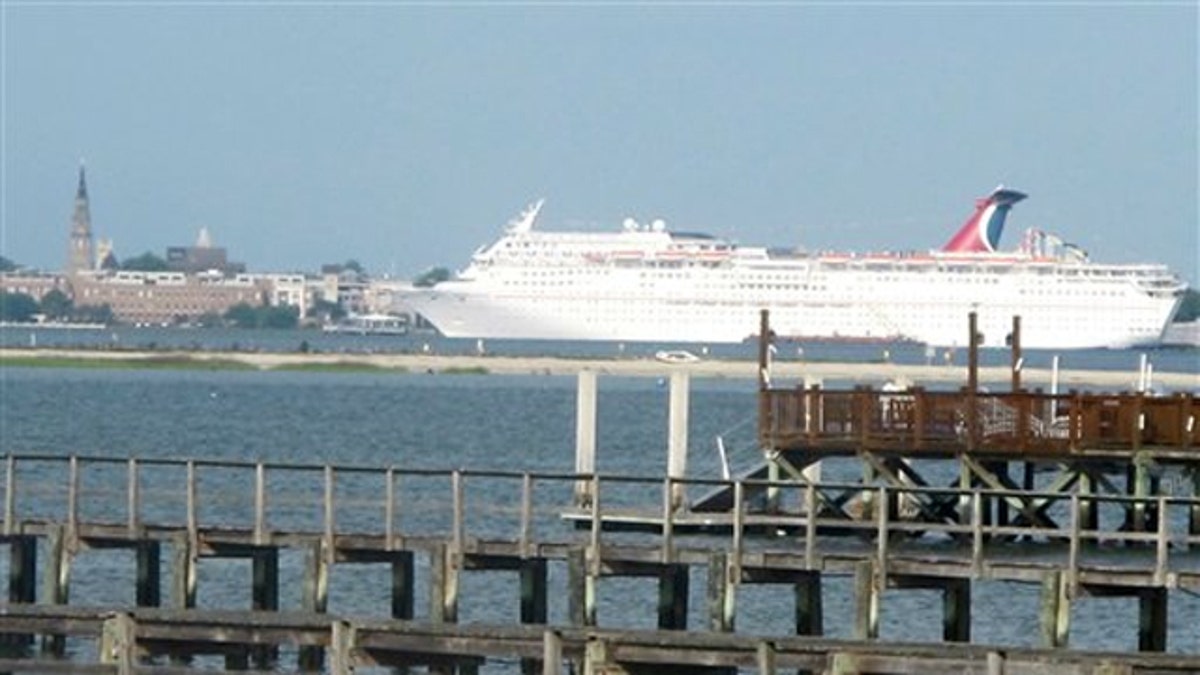
April 18, 2012: For more than two years the debate over cruise ships in Charleston has raged, with preservationists saying the city's historic character is at stake, while supporters claim they bring needed jobs. (AP)
Two years after Charleston became a year-round cruise destination, the arguments over the liners and their impact on this historic city continues unabated. It's a debate that has led to a lawsuit, conflicting economic studies, dueling billboard messages and emotions that run high.
Supporters say the cruises provide jobs, pour millions into the city's economy and are being managed appropriately. They say Charleston will always be a small market for cruises and won't be overwhelmed by the vessels as in someplace like Key West, Fla.
But others, including residents of one of the city's most historic neighborhoods, worry about soot from the liners' smokestacks darkening their window sills as well as the traffic, noise and congestion the cruise industry brings.
The National Trust for Historic Preservation last year put Charleston on "watch status," saying it could make the organization's list of endangered places because of threats from the growing industry.
In the past, Charleston hosted only a handful of seasonal cruises. But Carnival Cruise lines permanently based its 2,056 passenger liner Fantasy in Charleston two years ago, giving the city a year-round industry.
Now the South Carolina State Ports Authority plans to create a new $35 million cruise terminal by renovating a dockside warehouse up the Cooper River from its present aging cinderblock terminal that is more than 40 years old.
That's drawn fire from residents of the historic Ansonborough neighborhood as well as environmentalists. They want officials to consider other sites.
"The current project is irresponsible development because of the potential air, water and noise pollution and the aesthetic pollution of the skyline of our city," Ansonborough resident Debra Scott told state regulators at a permit hearing this month.
"I've worked on the docks for decades, and it's an industrial area," countered Robert New, who owns a port services company. "It's been an industrial area and a working dock for generations back to the 1700s, and if there is any sanity left in this community it will be a working dock for generations to come."
Opponents of the industry went to state court last year calling the Carnival vessels a public nuisance and alleging, among other things, that: the liners violate height ordinances; are illegal hotel operations; and their signature red, white and blue smokestacks violate city sign ordinances.
The lawsuit asked the court to block cruise operations and declare it illegal for the authority to put its new terminal at Union Pier.
The city of Charleston and the Ports Authority joined Carnival in asking that the lawsuit be dismissed. They contended, among other points, that waterfront has been used for passenger ships far longer than the city has had zoning laws. The state Supreme Court agreed in January to hear the case without it first winding through the lower courts.
If the case goes forward, the court would likely appoint a state judge to act as a special referee to take testimony and make recommendations to the justices.
The cruise controversy is nothing new for Charleston, a city that has experienced an urban renaissance during the past 30 years. During that time there have been similar heated disputes over a number of issues — the design of federal and county courthouses at the city's famed "Four Corners of Law;" the Charleston Place development that led to the revitalization of downtown; and the development of the South Carolina Aquarium, not far from where the new cruise terminal is planned.
In recent months, billboards on both sides of the cruise issue have competed for drivers' attention on Interstate 26 entering town. A group calling itself Cruise On In Charleston thanked the industry on a billboard while another urged those who read it to "Save Charleston. Support Cruise Control."
There have even been competing studies of the industry's impact.
A report commissioned by the Ports Authority determined cruises pump $37 million a year into the three-county Charleston area. But a second report commissioned for the Historic Charleston Foundation concluded downtown Charleston gets only a fraction of that while having to deal with the passengers, traffic and congestion the cruise ships bring.
Ports spokeswoman Allison Skipper said the terminal could be done by the middle of next year if permits are issued this summer.
Mayor Joseph P. Riley Jr. told regulators the plan is a good one in that it renovates an existing building and also opens 35 acres of authority land for redevelopment, allowing the public more access to the water.
Riley said about 84 liners will call in the city this year, which is in keeping with the scale of Charleston and won't overwhelm the city. He said there is a voluntarily agreement with the authority to keep the number in that range.
"It's an excellent plan and it's an environmentally sound plan and it's in the best interests of the community of Charleston and in the best interests of the people of South Carolina," he said.
But Dana Beach, the founder of the South Carolina Coastal Conservation League, one of the groups that sued Carnival, said other sites need to be considered and other environmental issues addressed.
He has suggested that shore power provide electricity to the ships at dock so they don't have to run their engines, something the authority has said is too expensive.
"This project explicitly facilitates a major source of pollution where ships run their engines at the docks 10 hours a day generating enough power to run the electric system of what is essentially a small town," he said. "We believe there are better ways to do this."
